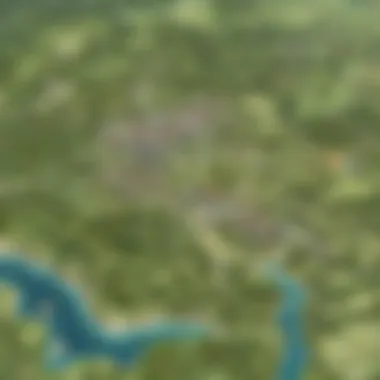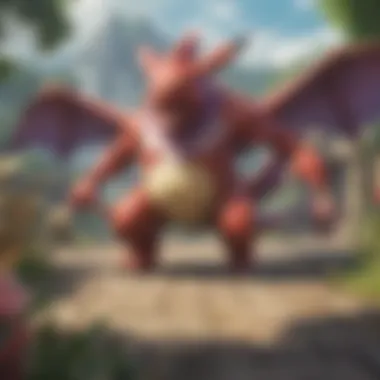Exploring Pokémon GO Locations: A Comprehensive Guide


Intro
In the world of mobile gaming, few titles have captured the imagination of players like Pokémon GO. Since its launch in 2016, it has transformed the way fans engage with the Pokémon universe. Players venture into their communities, seeking virtual creatures and battling alongside fellow trainers. This article provides a comprehensive overview of notable locations within Pokémon GO, aimed at enhancing your gameplay experience.
Understanding these locations helps both new and seasoned trainers get the most out of their adventures. With a focus on hotspots, urban hubs, and serene rural settings, players will find this guide useful not only for catching Pokémon but also for socializing and strategizing.
The dynamic nature of in-game environments, influenced by real-world events and seasonal changes, ensures that there is always something fresh to explore. By the end of this guide, trainers will have the necessary insights to navigate the expansive realms of Pokémon GO effectively.
Prelude to Pokémon GO Locations
In the world of Pokémon GO, the significance of locations cannot be overstated. Each in-game location serves as more than just a backdrop for a trainer's adventure; they actively shape how players interact with the game. Understanding the dynamics of Pokémon GO locations is essential for maximizing gameplay and enjoying the overall experience. This article will explore various types of locations, how they influence encounters, and strategies that trainers should use to enhance their gaming sessions.
The Importance of Location in Gameplay
Locations are the heartbeat of Pokémon GO. They dictate where trainers find Pokémon, how often they encounter them, and what types they might discover. Key locations such as PokeStops and Gyms offer resources that are crucial for advancing in the game. Players who understand their surroundings can more effectively plan their in-game actions.
Good location strategies often lead to discovering rare Pokémon or accessing special events. Consequently, grasping the importance of location is not only about improving gameplay, but it also adds a layer of excitement and anticipation to the experience. Players are not passive consumers of the game but are active explorers, transforming their real-world environment into a vibrant Pokémon hunting ground.
How Locations Influence Pokémon Encounters
The interaction between location and Pokémon encounters is multifaceted. Biomes found within certain areas can significantly change the type of Pokémon that spawn. For instance, urban centers might yield a larger variety of electric and steel types, thanks to the infrastructure found in cities. Conversely, rural settings may correspond with a different assortment of Pokémon that align more closely with natural environments, such as grass or water types.
Furthermore, the presence of landmarks or areas designated as Pokémon GO Points of Interest can increase the likelihood of encountering specific Pokémon. The game utilizes GPS data to integrate real-world geography into encounter mechanics, making certain locations hot spots for Pokémon discovery. Hence, players are encouraged to venture into diverse areas, as their localized knowledge can provide a competitive edge.
"Exploring various locations not only enhances gameplay but also enriches the overall Pokémon experience, allowing players to discover unique creatures in unexpected places."
Types of Locations in Pokémon GO
The variety of locations in Pokémon GO plays a crucial role in shaping the experiences of players. Different types of locations provide unique opportunities for capturing Pokémon, collecting items, and engaging with other players. Understanding these locations can significantly enhance gameplay, allowing trainers to strategize their movements and optimize their encounters. From urban environments to rural gems, each location type presents distinct advantages and considerations, making it vital for trainers to familiarize themselves with the landscape.
PokeStops and Gyms
PokeStops and Gyms are foundational components of Pokémon GO, acting as hubs where players can gather necessary items and participate in battles. PokeStops are scattered throughout various neighborhoods, parks, and landmarks. These stops replenish items such as Poké Balls, potions, and berries. The ability to spin a PokeStop every few minutes means trainers can regularly restock their supplies, an essential factor for success in the game.
Gyms, on the other hand, serve as battlegrounds where players can challenge opponents and build their skills. Capturing and defending a Gym provides players with rewards and helps establish community dominance. Trainers need to be aware of the Gym's level and the Pokémon defending it. This knowledge allows for informed decisions on when and how to engage, adding a layer of strategy that can be critical in intense competitions.
Wild Spawns and Biomes
Wild spawns refer to Pokémon that appear in the open world without specific interactions like spinning a PokeStop. The types of Pokémon that spawn in a given area depend heavily on the biome, which includes factors such as geographical regions, climate, and time of day. For example, park areas might yield grass-type Pokémon, while coastal regions could have water-types.
Players should take advantage of the changing nature of spawns, as certain Pokémon appear more frequently during specific hours or conditions. This temporal aspect adds an excitement factor to exploration. In addition, trainers can record their observations of spawns to identify patterns that may lead to more efficient gameplay.
Event Locations and Their Significance
Event locations in Pokémon GO are typically tied to special in-game activities, festivals, or community days. These locations often host notable Pokémon spawns or exclusive raids. Participating in these events not only fosters a sense of camaraderie among players but also offers chances to catch rare Pokémon and earn significant rewards.
The importance of event locations cannot be overstated. They provide unique engagements that break the routine of typical gameplay. Players are encouraged to stay updated on scheduled events via platforms like Reddit or Facebook. Trainers should plan their outings around these events to maximize their adventures effectively.


"Understanding the types of locations in Pokémon GO leads directly to improving your gameplay and enhancing your overall experience."
In summary, the knowledge of types of locations—PokeStops and Gyms, wild spawns and biomes, and event locations—is vital for creating a successful strategy. Each offers something distinct, enriching the overall experience for both dedicated and casual players alike.
Urban Locations for Optimal Gameplay
Urban locations are essential for maximizing the gameplay experience in Pokémon GO. Unlike rural or suburban areas, cities are generally teeming with diverse PokéStops and Gyms. These locations provide Pokémon trainers with opportunities to engage in various in-game activities such as raids, battles, and easy access to Poké Balls. Moreover, urban settings often have a higher frequency of unique Pokémon encounters, making them critical for trainers looking to complete their Pokédex.
Additionally, many urban areas feature event-specific locations that attract Pokémon. This increases the likelihood of rare spawns. Engaging with urban environments allows trainers to connect with local communities, which can enhance their gameplay. The strategic use of urban locations can lead to significant advantages in capturing Pokémon and completing challenges.
City Parks and Open Spaces
City parks and open spaces are ideal for catching Pokémon in an urban context. Not only do they provide a refuge from the hustle and bustle of city life, but they also often serve as hotspots for various Pokémon types. These natural areas frequently include multiple PokéStops and Gyms, allowing trainers to replenish supplies or battle.
While exploring these spaces, trainers can encounter both wild Pokémon and those emerging during specific events. Parks tend to have a varied ecosystem, which can lead to a wider variety of Pokémon spawns. Examples of popular parks include Golden Gate Park in San Francisco and Central Park in New York City.
To maximize the advantages of city parks, trainers should consider the layout of the park, as well as the typical weather conditions. For instance, sunny days may boost Grass-type spawns, while rainy conditions might favor Water-types. Leveraging these patterns can substantially elevate one’s gameplay.
Landmarks and Historical Sites
Landmarks and historical sites are another critical aspect of urban Pokémon GO gameplay. These locations often function as PokéStops or Gyms, making them natural meeting points for trainers. Additionally, their significance can lead to increased foot traffic, which can be beneficial for capturing rare Pokémon.
Exploring these sites can also add an educational element to the experience. Trainers often learn about local history while searching for Pokémon. Historical sites like the Statue of Liberty or the Eiffel Tower draw attention not only for their significance but also for the unique Pokémon that may appear around them.
To take advantage of these prime locations, players should plan visits during community events or peak hours to encounter more trainers. Being aware of upcoming events tied to local landmarks can lead to a more fruitful and enriched experience. Utilization of tactical planning, in conjunction with these popular spots, will lead to a more productive adventure.
Urban locations provide a consistent and diverse range of interactions for Pokémon GO trainers.
In summary, urban locations offer a wealth of opportunities for Pokémon trainers looking to enhance their gameplay. City parks and open spaces, along with landmarks and historical sites, can be effectively utilized for capturing and battling Pokémon. This strategic approach can lead to significant rewards and accomplishments in the game.
Rural and Suburban Locations
Rural and suburban locations offer unique opportunities for players of Pokémon GO. These environments are often less congested than urban settings. This factor can enhance the gameplay experience for those looking to explore at a more leisurely pace. Natural landscapes, parks, and community gathering spots are examples of locations that can be especially rewarding for finding rare Pokémon and participating in various in-game activities.
In rural areas, the absence of heavy urban development results in expansive stretches of land that may host a variety of Pokémon species. This factor encourages players to take longer walks, strengthening both their physical fitness and their connection to nature. Suburban locations can also serve as a balance. They often have a mix of residential areas and public parks that facilitate community play.
Overall, rural and suburban locations yield significant benefits:
- Less Crowded: Minimum distractions from other players.
- Variety of Pokémon: Different types may appear due to unique biomes.
- Community Engagement: Local gatherings foster strong trainer networks.
Leveraging Natural Landscapes
Natural landscapes can dramatically influence gameplay. Many players find rural areas appealing due to open spaces and serene environments. By seeking out these locations, players might uncover opportunities not available in cities. Rivers, mountains, and forests create diverse habitats. These areas are often rich with specific Pokémon that thrive in such conditions.
To optimize search and capture, consider the following steps:
- Research Local Flora: Some Pokémon are associated with certain plants. Knowing the area's flora may help predict what can be found.
- Visit During Events: Many seasonal events incorporate rural themes. Time your visits accordingly for better chances of sighting rare Pokémon.
- Utilize Tools: Employ Pokémon tracking apps or consult community forums such as Reddit for tips on hotspot locations.


Community Gathering Spots
Community gathering spots present another angle for gameplay in rural and suburban settings. These locations are not only valuable for finding Pokémon but also foster social interactions among players. They may include local parks, community centers, or even libraries that host events for trainers.
By participating in community activities, players can:
- Trade Pokémon: Find trainers interested in swapping Pokémon to complete collections.
- Coordinate Raids: It’s easier to arrange group battles at a known hotspot.
- Share Strategies: Engaging with other players can lead to sharing tips and successful experiences.
Important note:
Engaging with local trainers can provide a competitive edge and enhance your experience in Pokémon GO.
In summary, rural and suburban locations should not be overlooked. They offer distinct advantages that can lead to a well-rounded and enjoyable gameplay experience.
Seasonal Variations in Pokémon Locations
Understanding seasonal variations in Pokémon locations can greatly enhance the gameplay experience in Pokémon GO. Different seasons bring unique Pokémon spawns, altering not only what players can catch but also when and where they can find these creatures. Factors such as temperature, daylight hours, and even seasonal events influence the locations where players can interact with Pokémon. Recognizing these patterns is beneficial for both casual and dedicated trainers, enabling them to plan effective catchment strategies throughout the year.
Spring, Summer, Autumn, and Winter Changes
Each season presents distinct opportunities and challenges for trainers.
- Spring: During this season, Pokémon such as Oddish and Butterfree commonly appear. The blooming flowers and warmer weather encourage outdoor activity, making parks and gardens hotspots for Pokémon encounters. Special events often coincide with holidays like Easter, introducing limited-time Pokémon and bonuses.
- Summer: The summer months feature a wide array of Pokémon, including Magikarp and Snorlax. The long days allow for extended gameplay, particularly during the evenings. Players also find that water-type Pokémon become more prevalent near beaches and lakes, making those locations ideal for summer catch outings.
- Autumn: With the changing leaves, trainers may encounter different species like Pidgey and Bagon. Festivals celebrating harvests might be organized, providing a chance to catch unique Pokémon that may not appear at other times of the year. This is also when many trainers focus on community events.
- Winter: The colder months tend to feature various ice-type Pokémon. Players might notice an increase in Pokémon such as Swinub and Snorunt in snowy areas. The landscape can dictate where players go, as icy terrains may restrict access to some spots while enhancing the thrill of others.
Impact of Weather Conditions
Weather plays a crucial role in determining Pokémon availability and types. Each condition can significantly affect gameplay, influencing which Pokémon appear at specific locations.
- Clear and Sunny: Trainers can expect a good spawn of grass and ground-type Pokémon. Pokémon like Bellsprout and Maractus thrive in such conditions.
- Rainy: This weather typically increases encounters with water-type Pokémon such as Psyduck and Wingull. Additionally, rainy weather can stimulate the appearance of some bug and grass types, enhancing diversity.
- Foggy: The foggy weather conditions result in the prominence of ghost-type Pokémon like Drifloon and Shuppet. Trainers might notice a mystery element with these appearances, drawing interest to urban areas during this atmospheric condition.
- Windy: Windy conditions favor the spawning of flying and psychic types, offering players opportunities to catch Pokémon such as Pidgeotto or Alakazam.
"Adapting to local weather patterns can be a key differentiator among trainers, identifying the best times and places to hunt for specific Pokémon."
Advanced Strategies for Finding Pokémon
Finding Pokémon in Pokémon GO requires more than basic knowledge of the game; it demands a strategic approach. Understanding advanced strategies can significantly enhance one’s gameplay experience. By leveraging various tools and community resources, players can gain a competitive edge. This section explores several techniques that can maximize Pokémon encounters and improve in-game efficiency.
Leveraging Tools and Resources
GPS Spoofing
GPS Spoofing refers to the practice of manipulating your device's GPS location. This technique is popular among some players who wish to access Pokémon not naturally found in their immediate environment. It allows trainers to explore distant areas where rare Pokémon appear more frequently.
It is important to consider the risks associated with GPS Spoofing. While it offers access to diverse locations, it can lead to penalties from Niantic, potentially resulting in account bans. The key characteristic that makes GPS Spoofing enticing is its ability to bypass geographical restrictions. However, the disadvantages include the possibility of losing access to the game altogether.
Pokémon Tracking Apps
Pokémon Tracking Apps serve as a vital resource in finding Pokémon. They provide players with real-time data about the spawn rates and locations of different Pokémon. These apps enhance the overall experience by giving detailed insights into when and where Pokémon might appear.


The unique feature of these apps is their ability to aggregate information from multiple users, providing community-sourced data. The use of tracking apps is beneficial because it allows players to plan their hunting routes more effectively. However, not all tracking apps are reliable or safe, so users must choose wisely.
Social Media Groups
Social media groups are another excellent tool for trainers looking to enhance their gameplay. Platforms like Facebook and Reddit host numerous communities devoted to Pokémon GO, where players exchange tips and locations. These groups facilitate discussions about local hotspots, community events, and rare Pokémon sightings.
The key characteristic of social media groups is the sense of community they foster. Players can share experiences, strategies, and support each other in their journeys. It becomes easier to find grouped events or trades within the community. One disadvantage could be the potential for misinformation circulating, so it’s essential to verify critical information.
Community Events and Swaps
Community events are an excellent way for trainers to engage with others while increasing their Pok�émon roster. They often feature increased spawn rates, special Pokémon, and other benefits that can enhance gameplay.
Moreover, the practice of trading Pokémon during community swaps allows players to exchange duplicates or find Pokémon that they might not have access to otherwise. Participating in these events helps develop friendships and connections with other local trainers, enriching the gaming experience.
By utilizing these advanced strategies, trainers can optimize their Pokémon hunting, making their gameplay significantly more rewarding.
Safety Considerations While Exploring Locations
In the world of Pokémon GO, immersive gameplay is often tied closely to the physical locations where players roam. However, as enticing as it may be to chase elusive Pokémon, safety must not take a backseat. This section emphasizes the necessity of making informed choices when selecting environments for exploration.
Choosing Safe Environments
The first step in ensuring a secure Pokémon hunting expedition is choosing the right environments. Urban landscapes, while rich in PokeStops and Pokémon spawns, can pose unique safety challenges. Busy streets and poorly lit areas might create risks. When selecting a location, consider the following:
- Well-lit Areas: Choose locations that are well lit, especially if exploring during evening hours. This enhances visibility.
- Crowded Places: Opt for spots that are frequented by others. Public parks or popular landmarks are usually safer choices as there are many people around.
- Community Feedback: Engage with local communities, like those on Reddit or Facebook, to learn about safe and unsafe areas. Many trainers share their experiences, which can provide valuable insights.
By being mindful of these factors, trainers can enjoy the adventure without compromising their well-being.
Awareness of Surroundings
Maintaining awareness of one’s surroundings is a principal aspect of safety while exploring. Pokémon GO encourages players to immerse themselves in the environment, yet this should not lead to distraction from real-world situations. Consider these practices for enhanced safety:
- Stay Alert: Keep your head up and be aware of your surroundings. This helps avoid hazards such as vehicles or obstacles in your path.
- Avoid Isolation: If you are playing in a less populated area, consider bringing a friend along. Solo exploration can sometimes lead to unexpected situations.
- Observe Local Conditions: Weather conditions can influence safety too. Heavy rains or storms can create hazardous conditions, and it’s best to check forecasts before heading out.
"Safety should always be a priority for those navigating the expansive realm of Pokémon GO. With the right choices, trainers can enjoy their adventure without fear."
By prioritizing safe locations and staying alert, players can ensure that their Pokémon GO experience remains enjoyable and secure.
Culmination and Future of Pokémon GO Locations
In the world of Pokémon GO, the significance of locations cannot be overlooked. The conclusion of this article brings together the diverse aspects discussed about various gameplay environments. Locations serve not just as mere coordinates on a map but as vital ecosystems for gameplay. They influence player strategies, community interactions, and overall engagement with the game. Understanding this dynamic aids players in maximizing their Pokémon adventures.
Evolving Landscape of Gameplay
The landscape of Pokémon GO is in constant flux. As the game evolves through updates and player feedback, so do the locations within it. Niantic consistently introduces new features and tweaks existing ones. This transformation might involve more specific geographical features being recognized or new event locations popping up. Players will notice more ways in which their surroundings can enhance their gameplay experience.
For instance, augmented reality events can reshape familiar parks or landmarks into vibrant hubs of activity. Keeping up with these updates is beneficial. Forming strategies around the evolving landscape can lead to successful Pokémon capturing and trading experiences. Players should stay engaged with community forums and social media to track changes and share tips.
Anticipating Future Updates and Changes
Looking ahead, the potential for changes in Pokémon GO locations remains expansive. Niantic has hinted at plans for integrating new types of in-game locations and themes. This could merge real-world geography with seasonal themes, providing fresh quests and encounters. Players should be prepared for increased collaboration features or partnerships that may lead to exclusive events in diverse locations.
Changes also extend to technology. Emerging tools may streamline location tracking or provide new ways to engage within communities. Back-end adjustments to game mechanics can alter how players interact with locations, enhancing their overall gaming experience. Staying relative to this evolution can be a game changer.
"Understanding the ways in which Pokémon GO continues to change is essential for any dedicated player. Remaining adaptable ensures a richer gameplay experience."







